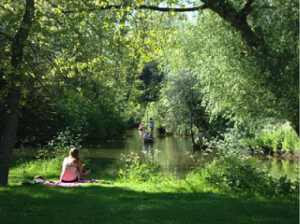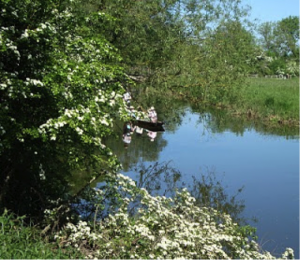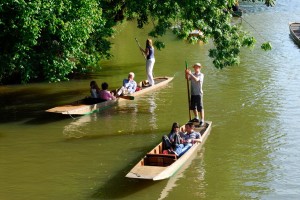The Cherwell
I’ve just finished a murder mystery novel from 1935, called Death on the Cherwell, by Mavis Doriel Hay. Not the most exciting of books, but interesting because Ms Hay set it in a mythical women’s college called Persephone College, which she sited near Parson’s Pleasure on the Cherwell River.
The two main rivers in Oxford are the Thames and the Cherwell. Toby and I walk along the Thames to get to Oxford from Iffley (although when it flows through Oxford it’s called the Isis, from the Latin name for the Thames, the Thamesis.)
When I was living at Linacre College in 2000/01 “my” river was the Cherwell, because my college room overlooked the New College Recreation Ground and beyond it to the Cherwell. It is a gentle, picturesque river and is just the place for a leisurely afternoon punt. And the banks are perfect for sitting and reading in dappled sunshine while others punt on by.
Parsons’ Pleasure is in the south-eastern corner of the University Parks. In the past, two millstreams were diverted from the main course of the river, which then flows into a weir. This meant that two very elongated islands formed between the streams and the top end of the larger island is Parson’s Pleasure. It’s a gorgeous place for a picnic on a sunny afternoon.
In the not so distant past, it was traditionally reserved for nude bathing and sunbathing by male academics. To avoid embarrassment when punting through this area, ladies would alight and walk round without peeking. It’s one of Oxford’s cherished stories that on one sunny afternoon a group of naked dons were startled by a punt filled with young ladies. The dons all hastily covered the less acceptable parts of their anatomy with their hands – except one, who covered his face instead. When quizzed about this later he said “I cannot answer for the rest of you, but I felt it important to cover that part of me by which I am most easily recognised.”
It really is a divine way to travel on the river.
THE OXFORD/CAMBRIDGE DEBATE
I saw someone punting today as we walked into town. He was standing on the platform and I turned to Toby and said, very officiously, “He’s standing at the wrong end. That’s the Cambridge way.”
Turns out that the true situation isn’t so cut and dry. Apparently Cambridge punts have a different (and obviously wrong!) design to those in Oxford; they have a sharply vertical prow and Cambridge punters are therefore forced to stand on the platform. Oxford punters usually stand in the punt itself, which we say is safer and less slippery. They can, if they wish, stand on the shelf, but if they do, people like me will mutter, “You’re at the Cambridge end, you moron.”
See how in the Oxford punt, the punter stands IN the punt.
In Cambridge the punter stands on the shelf-like prow.
HOW TO PUNT (from a book of instruction – I’m no expert)
Stand at the back of the punt, half-facing to the side (probably the right). Hold the pole vertically against the side of the punt (doesn’t matter whether or not it’s touching), and let it drop through your hands until it touches the riverbed. Swish or experienced punters throw the pole downwards, but we’ll save that for the advanced class. Push the pole downwards and backwards, gently at first, then more forcefully towards the end of the stroke (because, as your stroke “flattens” and the pole becomes closer to horizontal, less of your energy is going into pushing down into the riverbed, and more into pushing the punt forwards). For extra speed, bend your knees into the downstroke of the pole, so that you can get more push out of each stroke.
Try to push directly backwards, lest you swerve wildly to one side of the river. Let the pole trail behind the punt, acting as a rudder to guide the punt.
Now steer. You’ll probably need to steer a little on each stroke. You do this by moving the trailing pole through the water to the side you wish the nose of the punt to point in (want the punt to veer left? Move the pole behind you to the left side). Be gentle: there is so little friction on the water that the punt will be continuing the swing long after you’ve forgotten about it and gone on to the next stroke.
Finally, retrieve the pole hand over hand, and return to start. If the pole gets stuck, give it a half-twist and a gentle tug to free it.








